The iPhone 5 Performance Preview
by Anand Lal Shimpi on September 21, 2012 11:31 PM EST- Posted in
- Smartphones
- Apple
- Mobile
- SoCs
- iPhone 5
This morning we finally got our hands on Apple's iPhone 5. While we are eager to get started on battery life testing, that'll happen late tonight after a full day's worth of use and a recharge cycle. Meanwhile, we went straight to work on performance testing. As we've mentioned before, the A6 SoC makes use of a pair of Apple's own CPU cores that implement the ARMv7 ISA. These aren't vanilla Cortex A9s or Cortex A15s, but rather something of Apple's own design. For its GPU Apple integrated a PowerVR SGX543MP3 GPU running at higher clocks than the dual-core 543MP2 in the A5. The result is compute performance that's similar to the A5X in Apple's 3rd generation iPad, but with a smaller overall die area. The A6 has a narrower memory interface compared to the A5x (64-bits vs. 128-bits), but that makes sense given the much lower display resolution (0.7MP vs. 3.1MP).
As always, our performance analysis starts out on the CPU. Although we originally thought the A6 ran its two CPU cores at 1GHz, it looks like max clocks range between 800MHz and 1.2GHz depending on load. Geekbench reports clock speed at launch, which varied depending on CPU load. With an app download process in the background I got Geekbench to report a 1.2GHz clock speed, and with everything quiet in the background the A6 reported 800MHz after being queried. This isn't anything new as dynamic voltage/frequency adjustment is in all smartphones, but we do now have a better idea of the range.
The other thing I noticed is that without a network active I'm able to get another ~10% performance boost over the standard results while on a network. Take the BrowserMark results below for example, the first two runs are without the iPhone 5 being active on AT&T's network while the latter two are after I'd migrated my account over. The same was true for SunSpider performance, I saw numbers in the low 810ms range before I registered the device with AT&T.
Overall, the performance of the A6 CPU cores seems to be very good. The iPhone 4S numbers below are updated to iOS 6.0 so you can get an idea of performance improvement.
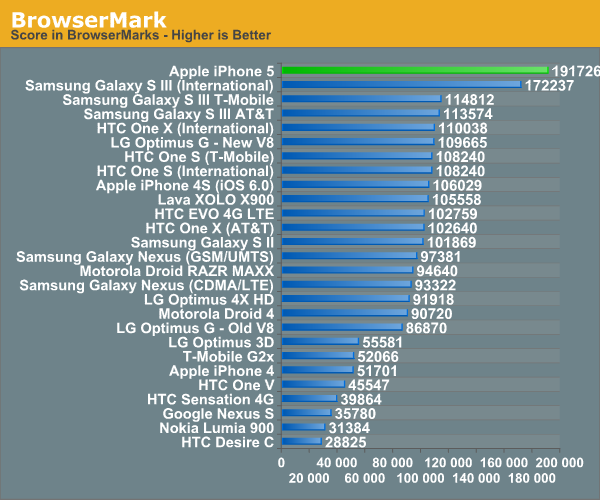
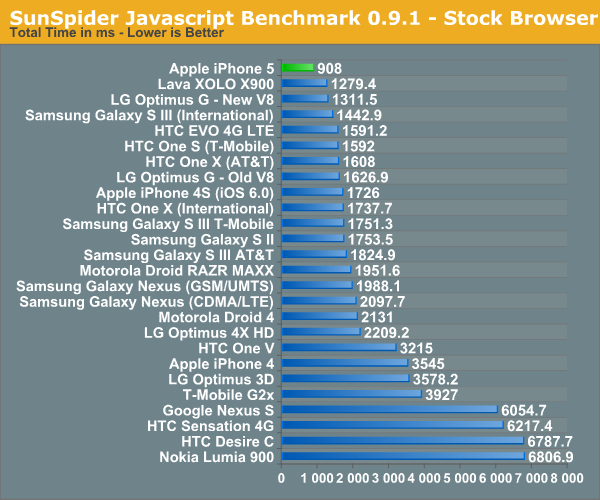
As we mentioned in our earlier post, SunSpider is a small enough benchmark that it really acts as a cache test. The memory interface on the A6 seems tangibly better than any previous ARM based design, and the advantage here even outpaces Intel's own Medfield SoC.
I also ran some data using Google's V8 and Octane benchmarks, both bigger JavaScript tests than SunSpider. I had an AT&T HTC One X with me while in New York today (up here for meetings this week) and included its results in the charts below. Note that the default HTC web browser won't run the full Octane suite so I used Chrome there. I didn't use Chrome for the V8 test because it produced lower numbers than the stock browser for some reason.
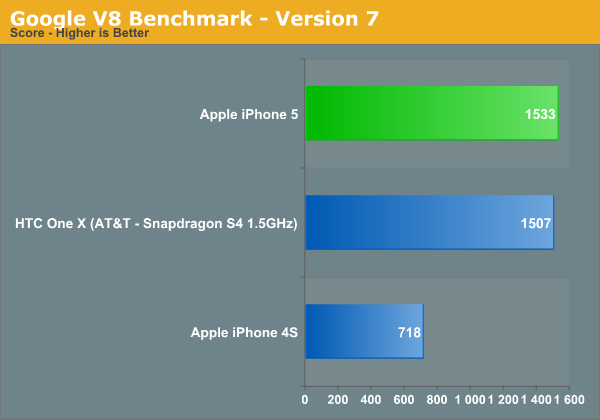
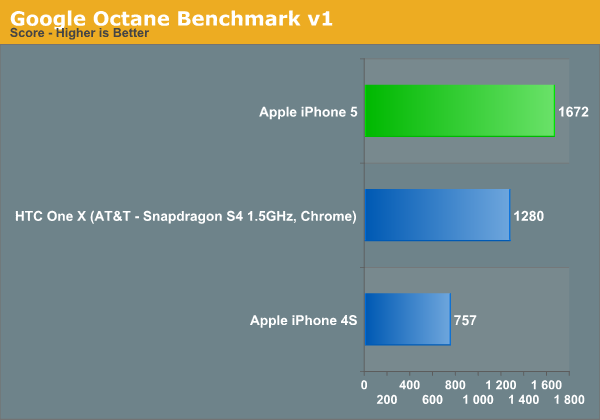
Here we see huge gains over the iPhone 4S, but much closer performance to the One X. In the case of Google's V8 benchmark the two phones are effectively identical, although Octane gives the iPhone 5 a 30% lead once more.
These are still narrowly focused tests, we'll be doing some more holisitic browser tests over the coming days. Finally we have Geekbench 2, comparing the iPhone 5 and 4S:
| Geekbench 2 Performance | ||||
| Geekbench 2 Overall Scores | Apple iPhone 4S | Apple iPhone 5 | ||
| Geekbench Score | 628 | 1640 | ||
| Integer | 545 | 1252 | ||
| Floating Point | 737 | 2101 | ||
| Memory | 747 | 1862 | ||
| Stream | 299 | 946 | ||
Apple claimed a 2x CPU performance advantage compared to the iPhone 4S during the launch event for the 5. How does that claim match up with our numbers? Pretty good actually:
This is hardly the most comprehensive list of CPU benchmarks, but on average we're seeing the iPhone 5 deliver 2.13x the scores of the iPhone 4S. We'll be running more application level tests over the coming days so stay tuned for those.
A6 GPU Performance: Nearly Identical to the iPad 3
Before we got a die shot of Apple's A6 we had good information pointing to a three core PowerVR SGX 543MP3 in the new design. As a recap, Imagination Technologies' PowerVR SGX543 GPU core features four USSE2 pipes. Each pipe has a 4-way vector ALU that can crank out 4 multiply-adds per clock, which works out to be 16 MADs per clock or 32 FLOPS. Imagination lets the customer stick multiple 543 cores together, which scales compute performance linearly. The A5 featured a two core design, running at approximately 200MHz based on our latest news. The A5X in the 3rd generation iPad featured a four core design, running at the same 200MHz clock speed.
The A6 on the other hand features a three core PowerVR SGX 543MP3, running at higher clock speeds to deliver a good balance of die size while still delivering on Apple's 2x GPU performance claim. The raw specs are below:
| Mobile SoC GPU Comparison | |||||||||||
| Adreno 225 | PowerVR SGX 540 | PowerVR SGX 543MP2 | PowerVR SGX 543MP3 | PowerVR SGX 543MP4 | Mali-400 MP4 | Tegra 3 | |||||
| SIMD Name | - | USSE | USSE2 | USSE2 | USSE2 | Core | Core | ||||
| # of SIMDs | 8 | 4 | 8 | 12 | 16 | 4 + 1 | 12 | ||||
| MADs per SIMD | 4 | 2 | 4 | 4 | 4 | 4 / 2 | 1 | ||||
| Total MADs | 32 | 8 | 32 | 48 | 64 | 18 | 12 | ||||
| GFLOPS @ 200MHz | 12.8 GFLOPS | 3.2 GFLOPS | 12.8 GFLOPS | 19.2 GFLOPS | 25.6 GFLOPS | 7.2 GFLOPS | 4.8 GFLOPS | ||||
| GFLOPS As Shipped by Apple/ASUS | - | - | 12.8 GFLOPS | 25.5 GFLOPS | 25.6 GFLOPS | - |
12 GFLOPS |
||||
The result is peak theoretical GPU performance that's near identical to the A5X in the 3rd generation iPad. The main difference is memory bandwidth. The A5X features a 128-bit wide memory interface while the A6 retains the same 64-bit wide interface as the standard A5. In memory bandwidth limited situations, the A5X will still be quicker but it's quite likely that at the iPhone 5's native resolution we won't see that happen.
We ran through the full GLBenchmark 2.5 suite to get a good idea of GPU performance. Note that the 3rd gen iPad results are still on iOS 5.1 so there's a chance you'll see some numbers change as we move to iOS 6.
We'll start out with the raw theoretical numbers beginning with fill rate:
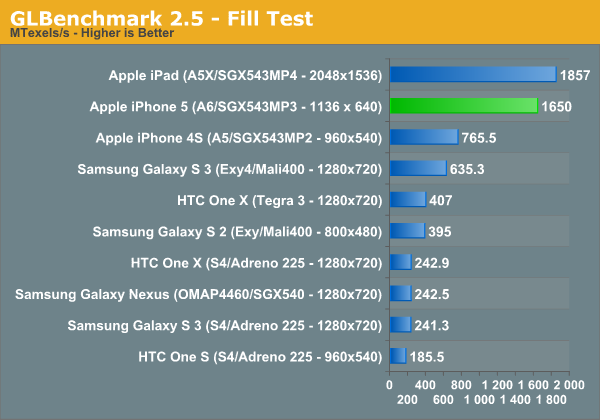
The iPhone 5 nips at the heels of the 3rd generation iPad here, at 1.65GTexels/s. The performance advantage over the iPhone 4S is more than double, and even the Galaxy S 3 can't come close.
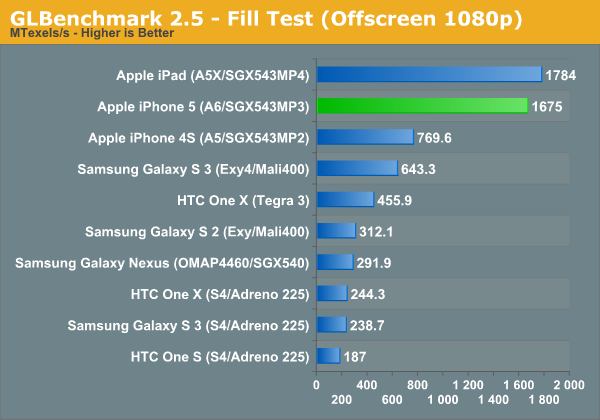
Triangle throughput is similarly strong:
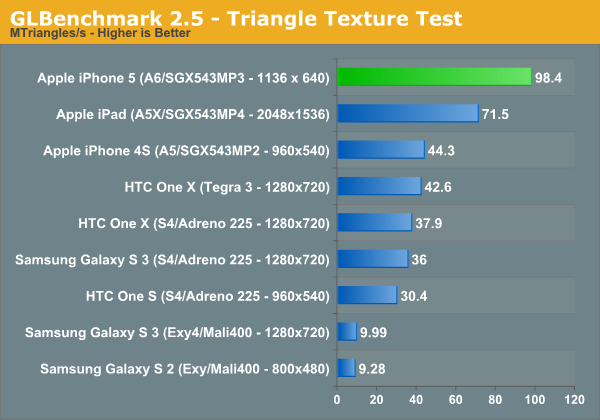
Take resolution into account and the iPhone 5 is actually faster than the new iPad, but normalize for resolution using GLBenchmark's offscreen mode and the A5X and A6 look identical:
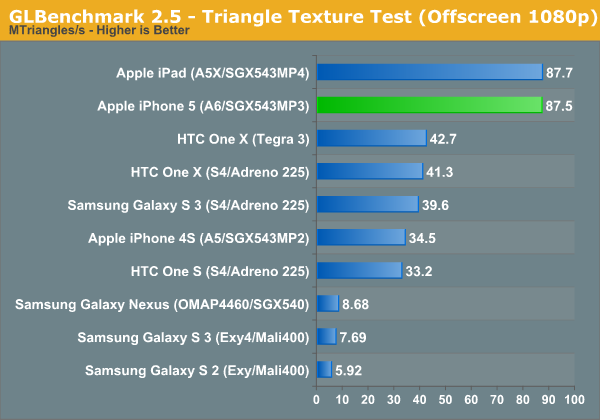
The fragment lit texture test does very well on the iPhone 5, once again when you take into account the much lower resolution of the 5's display performance is significantly better than on the iPad:
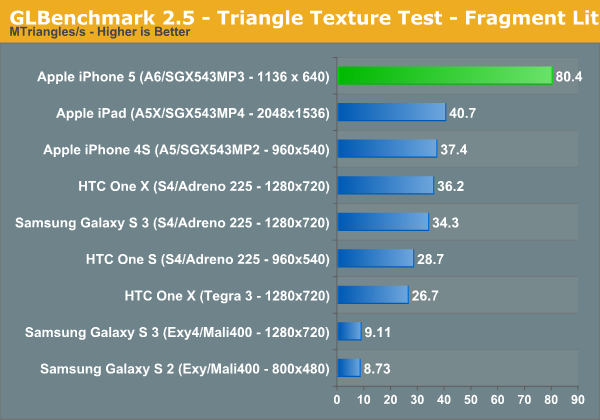
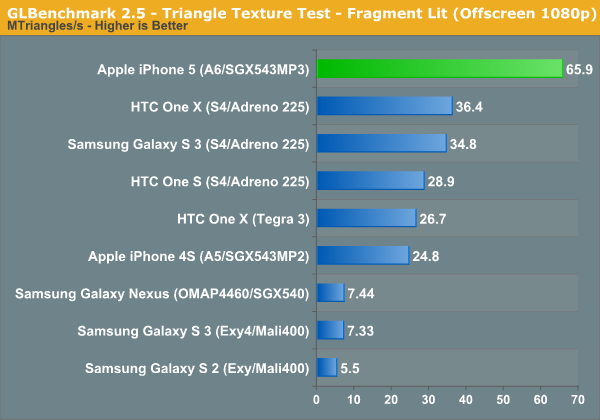
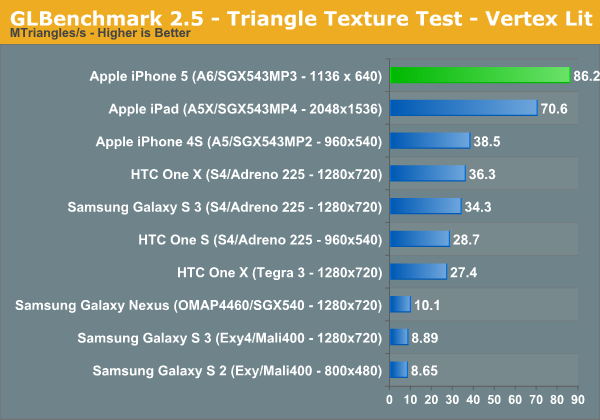
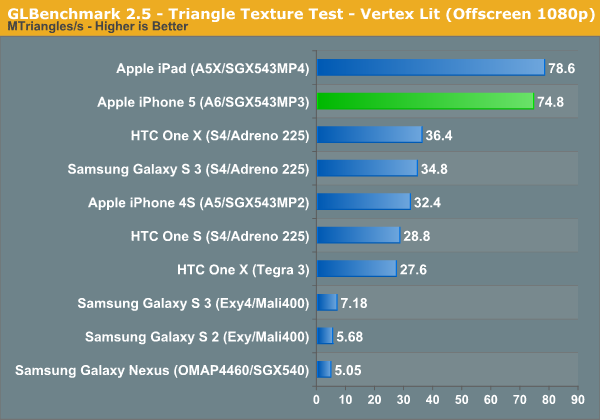
The next set of results are the gameplay simulation tests, which attempt to give you an idea of what game performance based on Kishonti's engine would look like. These tests tend to be compute monsters, so they'll make a great stress test for the iPhone 5's new GPU:
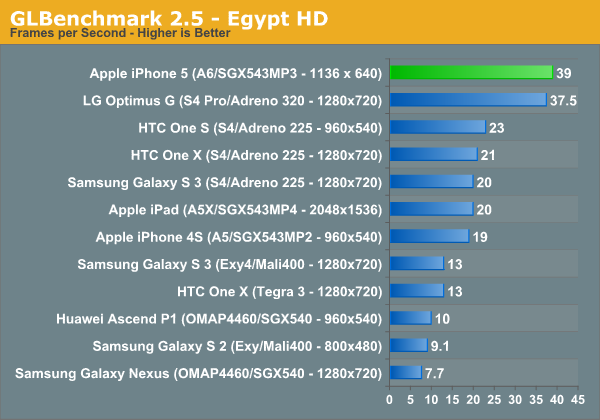
Egypt HD was the great equalizer when we first met it, but the iPhone 5 does very well here. The biggest surprise however is just how well the Qualcomm Snapdragon S4 Pro with Adreno 320 GPU does by comparison. LG's Optimus G, a device Brian flew to Seoul, South Korea to benchmark, is hot on the heels of the new iPhone.
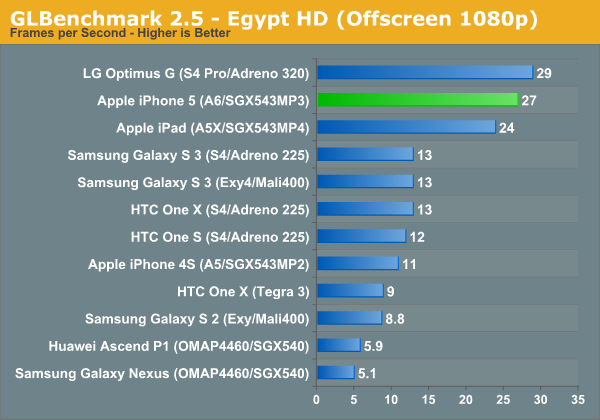
When we run everything at 1080p the iPhone 5 looks a lot like the new iPad, and is about 2x the performance of the Galaxy S 3. Here, LG's Optimus G actually outperforms the iPhone 5! It looks like Qualcomm's Adreno 320 is quite competant in a phone.
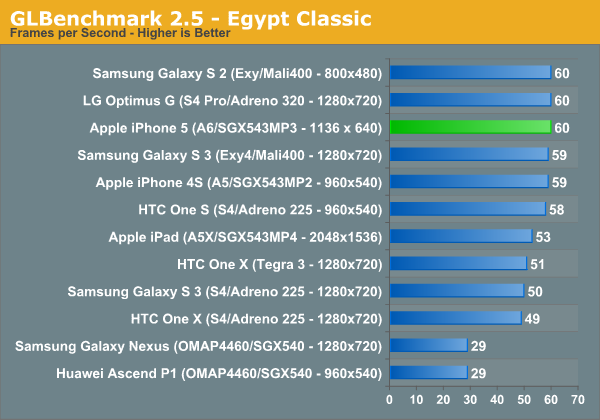
The Egypt classic tests are much lighter workloads and are likely a good indication of the type of performance you can expect from many games today available on the app store. At its native resolution, the iPhone 5 has no problems hitting the 60 fps vsync limit.

Remove vsync, render at 1080p and you see what the GPUs can really do. Here the iPhone 5 pulls ahead of the Adreno 320 based LG Optimus G and even slightly ahead of the new iPad.
Once again, looking at GLBenchmark's on-screen and offscreen Egypt tests we can get a good idea of how the iPhone 5 measures up to Apple's claims of 2x the GPU performance of the iPhone 4S:
Removing the clearly vsync limited result from the on-screen Egypt Classic test, the iPhone 5 performs about 2.26x the speed of the 4S. If we include that result in the average you're still looking at a 1.95x average. As we've seen in the past, these gains don't typically translate into dramatically higher frame rates in games, but games with better visual quality instead.
Final Words
We still have a lot of work ahead of us, including evaluating the power profile of the new A6 SoC. Stay tuned for more data in our full review of the iPhone 5.


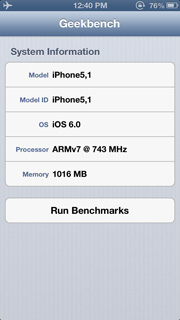

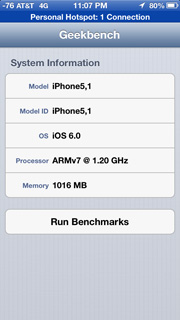
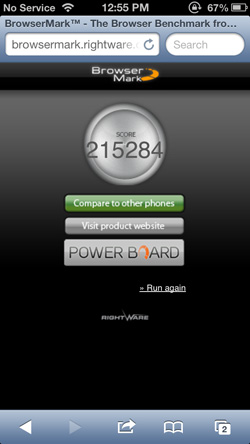
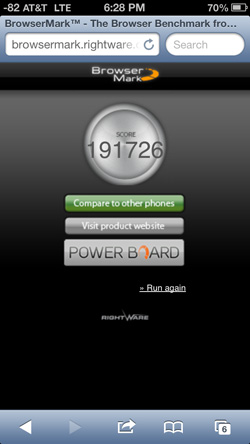










237 Comments
View All Comments
Becherovka05 - Saturday, September 22, 2012 - link
I agree the button is iconic of Apple, but the speaker placement is set by where your ear would be lol. Round corners are not Apple. And pinch to zoom is a fundamental was to use your phone I don't think that should be patterned and if it is should be cheap and available to everyone, like notifications that Apple copied from android. When I look at a Samsung phone I don't think that looks like a iPhone at all. And my local super market Woolworths logo does not look like apples logo.doobydoo - Monday, September 24, 2012 - link
Pinch to zoom is only fundamental because Apple made it so.And remember, Apple didn't patent 'pinch to zoom' - it patents its specific implementation, which is very different.
doobydoo - Monday, September 24, 2012 - link
Dock - not patentableIcon based OS - not patentable
'Copied Clock' - do I even need to answer this one.
Notifications - remains to be seen if they infringed Google's patent in implementation their own version. Google hasn't sued them over it yet which gives you part of your answer.
Copying things is legal, when it's legal. It's illegal, when you infringe patents / trade dress.
I don't know why you state phones have never been circular (shape wasn't anything to do with why Samsung lost), nor buttons (again, not why Samsung lost) nor making calls (again, not why Samsung lost). Ironically, the FRAND patents which Samsung is suing Apple over are for both 3G (which they tried and failed to ban the 4 over) and LTE (which they claim they will try to ban the 5 over).
The main items Samsung lost here were on the Utility patents, which has nothing to do with the shame. The decisions they did win on the design patents and trade dress were nothing to do with the shape claims. Making your final paragraph irrelevant.
To quote an article from a clearly more educated individual:
'Samsung contributed greatly to this with a post-trial statement that said: ““It is unfortunate that patent law can be manipulated to give one company a monopoly over rectangles with rounded corners, or technology that is being improved every day by Samsung and other companies.” It’s more unfortunate that the claim was a gross exaggeration that was swallowed whole by many writers.
Apple claimed that Samsung infringed on four design patents. The D’677 patent covers the overall design of the iPhone while D’305 covers the layout of icons. These claims were upheld. But the jury rejected infringement claims based on patent D’889, which covers the iPad, and rejected eight of 13 claims under D’087 and which deals specifically with the rectangles-with-rounded-corners design of the iPhone (see the relevant sections of the jury verdict form below.) '
http://techpinions.com/pinch-to-zoom-and-rounded-r...
It's only very simplistic, uninformed people who claim this case was about rounded corners, etc - exactly the type of person I wouldn't expect to find on Anandtech.
Becherovka05 - Monday, September 24, 2012 - link
http://www.youtube.com/watch?v=8QzJa_OU0tIdoobydoo - Sunday, September 30, 2012 - link
All this quote refers to is taking inspiration from other products whilst adding your own value.It does not relate to illegally infringing patents / trade dress.
Becherovka05 - Monday, September 24, 2012 - link
Most companies don't sue other company's over minor infringements. This has been a core part of apples strategy And this is the reason I dont own a apple product. Its not that I dont think they are good for people that want a fun phone with good games thats easy to use. And the Ipad is really good. Apple still sucks a55 as a company. And even Woz said this last win over samsung was BS. Your link is bias and there are plenty with the opposite bios. Jobs wanted to go "Thermo Nuclear" on android, they have proven this to be the case. And if this was just about Samsung I wouldnt have a problem, but its been every company thats produced a competing phone. They just dont want to have competition. I like competition hence I dont like a company that tries to remove it.Becherovka05 - Monday, September 24, 2012 - link
Note: The original version of this post said the jury had rejected all claims regarding the rounded-corner design. The jury in fact rejected all claims only regarding willful infringement. On the simple question of infringement, the jury rejected a majority of claims, but did accept five regarding the iPhone. The corrected version appears above.doobydoo - Sunday, September 30, 2012 - link
I quoted the amended article, it needs no further qualification.That your only argument to the article is that it is 'bias', is frankly only representative of your own bias.
The 5 claims which were accepted did not related to rounded corners, as the quote I already pasted proves.
And to claim other companies aren't suing over trivial things - they've gone a step further. Samsung tried to ban the 4S over 3G - with a zero hit rate, and claims it will try to ban the 5 over LTE - both FRAND patents and Samsung is already under investigation for that.
They don't sue over 'trivial' (read: utility, design & trade dress) patents because Apple hasn't infringed any.
kyuu - Sunday, September 23, 2012 - link
Apple copied as much, if not more, from other companies' products as anyone copied from Apple. Quit pretending that Apple's legal shenanigans are anything other than anti-competitive trolling, please.doobydoo - Monday, September 24, 2012 - link
There is a difference between copying things which are in the public domain, not patented/patentable - and doing them in your own way, to outlining a 132 page document on how you plan to replicate technology which has been patented whilst offering no value or originality of your own.